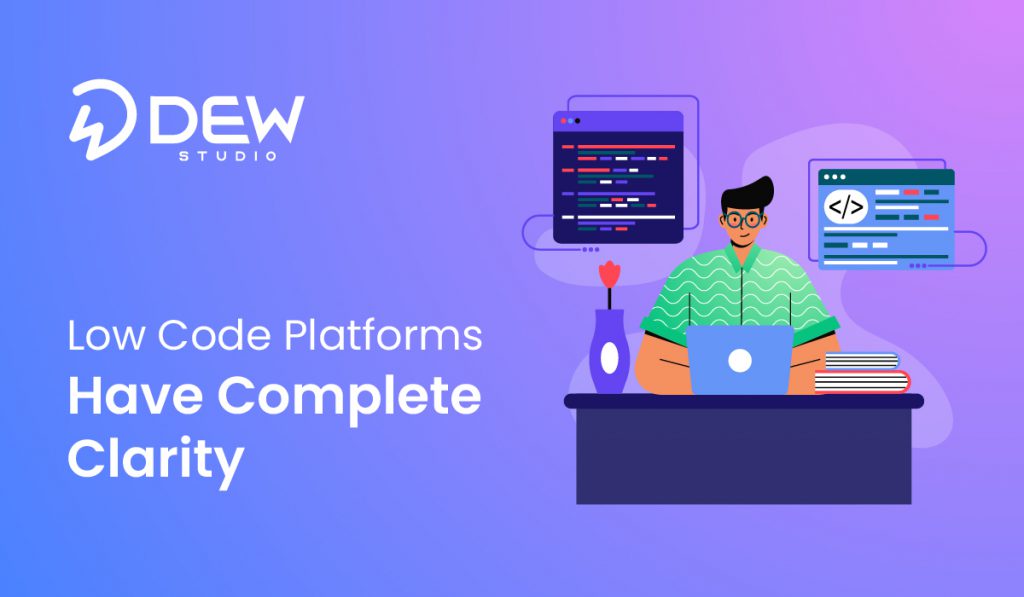The critical aspect of software development is its cost. Many enterprises or developers expend extensive money and resources on software application development without understanding the viability, market, or possible scalability.
Here, two negatives arise. One is the waste of funds and resources that might be utilized in other places or for different programs. The second is that the developed application doesn’t yield any return. So the enterprise has to start the exhausting application development process once again.
So, can’t this situation be avoided? Yes, it can be!
To pre-test the viability of software or an application, a process called MVP is used. The Minimum Viable Product (MVP) approach to low-code and no-code solutions comes in handy.
Low-code No-code Solution And MVP (Minimum Viable Product)
The term “low-code, no-code” development approach refers to a method of creating and deploying custom applications that uses little to no traditional coding. Additionally, it has a visual user interface and pre-designed components that can be customized.
MVP refers to a low-code, no-code solution that can be developed and validated without requiring the heavy investment of skilled teams and other resources.
A low-code, no-code development approach brings down the time, usage of resources, and entire software development life cycle to the bare minimum. Understanding this potential, every idea for a software application can be tested in advance to find out its viability.
So even before developing an application, it can be tested economically and quickly. Therefore, understanding and analyzing the pros and cons of MVP is important to moving forward.
Understanding Pros and Cons of MVP in Low-code
MVP is one cost-cutting and effective way of testing the viability and possible prospects of a custom mobile application or software product. A low-code development platform empowers enterprises and individuals to have an MVP with little resources and effort.
A basic prototype with minimal but main features is created and released to a dedicated or concentric group of users through a no-code, low-code platform. Thus, MVP helps to gather key customer feedback as well as attract prospective investors.
DEW Studio is a top low-code platform with specially designed software development environments with graphical user interfaces and pre-built templates.
There are different MVP approaches. Based on the need and scope of your application, you can choose one of the following:
- Multi-capability MVP: Here, MVP is created with both core functionality and important secondary features. It is created with multiple low-code tools blended with some level of manual coding.
- Single Feature MVP: With single feature MVP, we will just be sticking to one key feature aiming at the key problem the people are facing, that is, the public’s primary problem. For that feature to work properly, some additional features may be allowed to complement the primary feature. Low-code platforms are enough to build this MVP.
- Manual First or Concierge MVP: Along with the basic product, this approach helps in mimicking the backend processes for the application functionality. Even the employees of the enterprise can provide their recommendations. So without spending too much, we can gather heaps of crucial data about the application along with the assessment of its viability.
As we have learned about different MVP approaches, let us address the main aspect. The pros and cons of MVP are:
Pros Of Building An MVP With Low-code Solution
- As the platform is a no-code/low-code app development solution, there is no need for extensive engineering and technical skills. Anyone can get involved in this easily.
- With readymade tools and top-grade customizable components, the whole process and its results will be highly efficient and astoundingly effective.
- Lucrativeness and Cost-effectiveness are the primary attributes of this precious approach.
- With optimized backend processes and improving outdated systems, reduction of technical debt and overhead resources is possible here.
- Not just development, even the deployment happens faster.
Cons Of Building An MVP With Low-code Approach
- Technical constraints may arise when we want to inculcate extensive features that might need traditional programming help.
- The app gets locked into the vendor’s proprietary technology stack and deprives you of source code access. So the migration to another platform will be difficult.
- Basic knowledge and skills about the features of the platform are necessary. These fundamental skills are necessary for low-code no-code development platforms.
- Low-code no-code technology solutions might be highly secured, but integrating third-party software and databases might lead to new security concerns.
- Self-safeguarding measures and policies are essential to have for secured database management. These measures demand enough time and resources.
Final Words!
So, these are the primary benefits and drawbacks of creating MVP with a low-code or no-code approach. Analyze them before building the MVP in a low-code approach.
With pre-made or minimal custom coding, DEW Studio low-code app development platform enables the creation of avant-garde apps, the automation of workflows, and the integration of features. Get Started!

